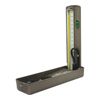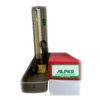ALPK2 MERCURIAL 300V Sphygmomanometer With Stethoscope
Key Features
-
A mercury instrument that may be carried about on your desk.
-
Cover that folds down and has a spring lock mechanism.
-
The indestructible plastic cartridge tube is graduated.
-
Red graduations with high visibility
-
For dependable performance, a filter system keeps mercury clean.
-
During storage, transport, or maintenance, a locking reservoir keeps mercury safe.
-
Mis-cuffing is avoided thanks to the nylon cuff mechanism.
-
Filter screen protection on the bulb and valve
Product Description
ALPK2 MERCURIAL 300V Sphygmomanometer With Stethoscope Description Apparatus ALPK2 B.P Mercurial is most usually measured with a sphygmomanometer, which used to reflect circulating pressure by the height of a mercury column. Although aneroid and electronic devices do not contain mercury, blood pressure readings are commonly reported in milli-meters of mercury (mmHg). An inflatable cuff, a measurement device (mercury manometer), and a mechanism for manually inflating the bulb and valve make up the ALPK2 Mercurial Sphygmomanometer. The body of this blood pressure monitor is made of aluminum die cast. How To Use: One tube from the bladder should be connected to the air release valve and bulb. Connect the manometer to the other bladder tube. Wrap the cuff around your upper left arm and secure it using Velcro. Make sure the arrow on the cuff is over the brachial artery. Place the chest piece of a stethoscope (not included) under the cuff’s edge where the arrow points. Turn the air release valve knob clockwise while holding the bulb and pump the bulb until the point reaches to roughly 40 points over the persons typical systolic pressure. Turn the knob counter-clockwise to progressively deflate the cuff (approximately 2 to 4 points per second). Record the mercury gauge measurement at the instant where the first beat is heard. The systolic pressure is this number. While listening to the pulse beat, continue to deflate the cuff. When the pulse beat is no longer audible, note the mercury gauge measurement. This is the pressure in the diastole.


